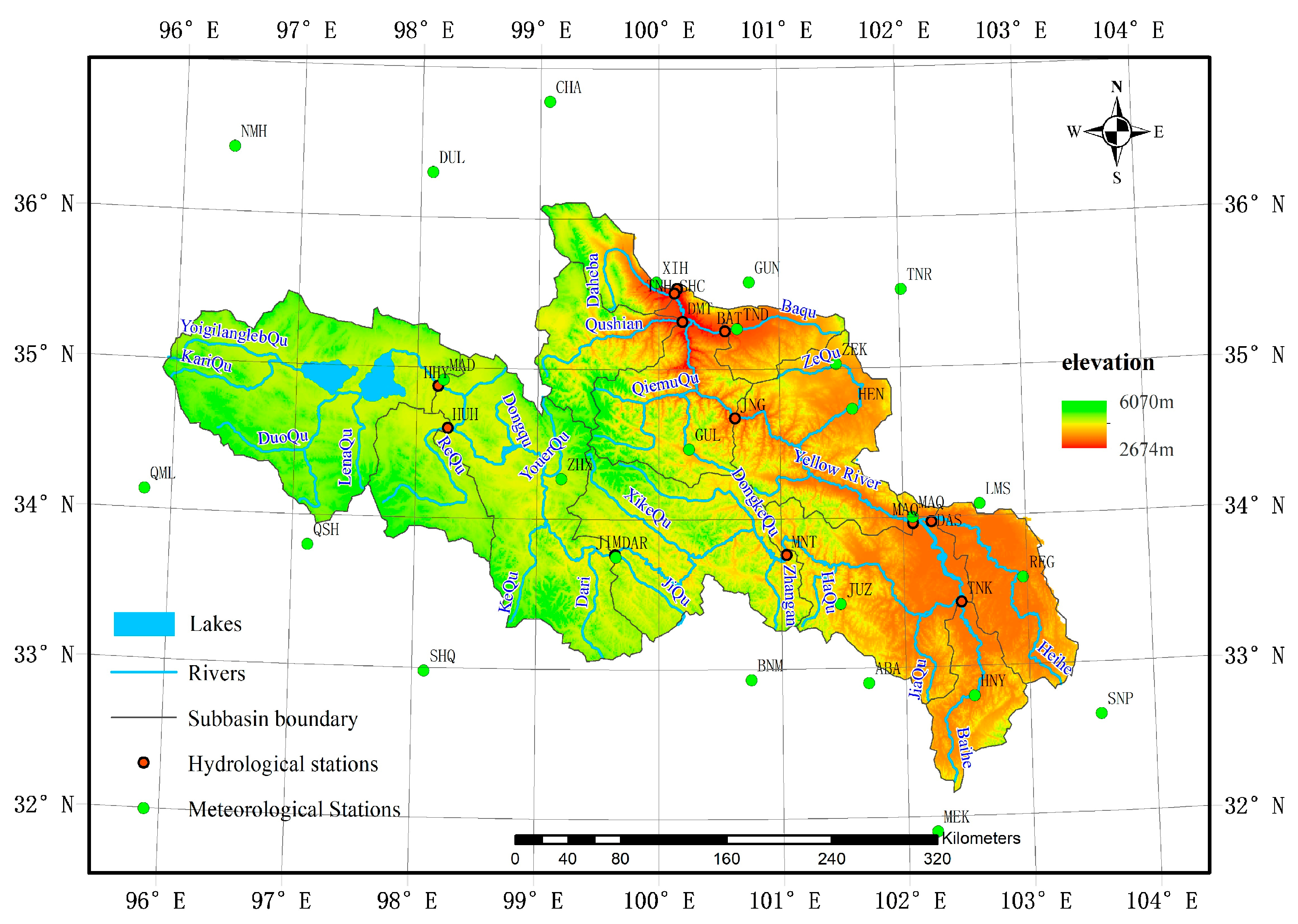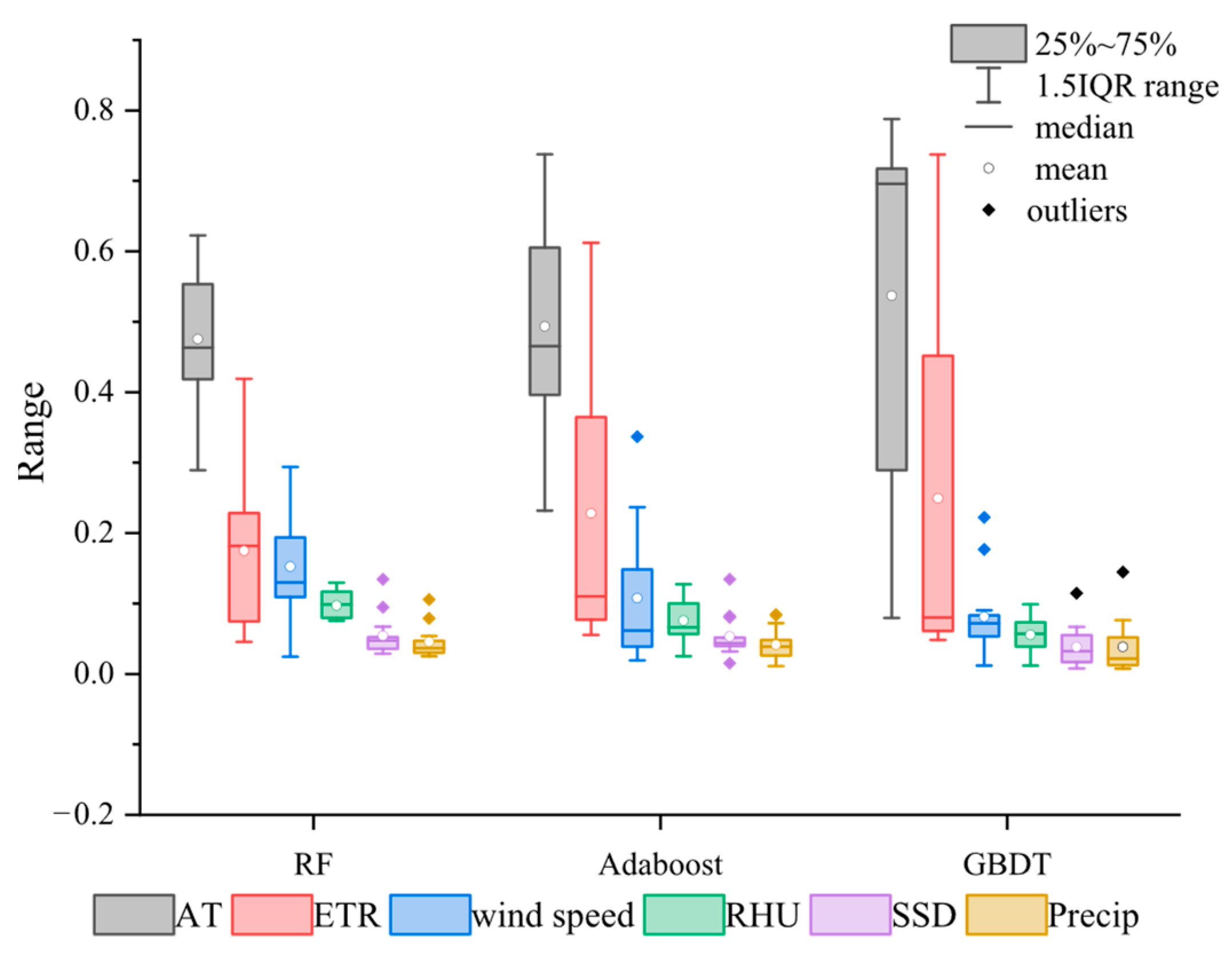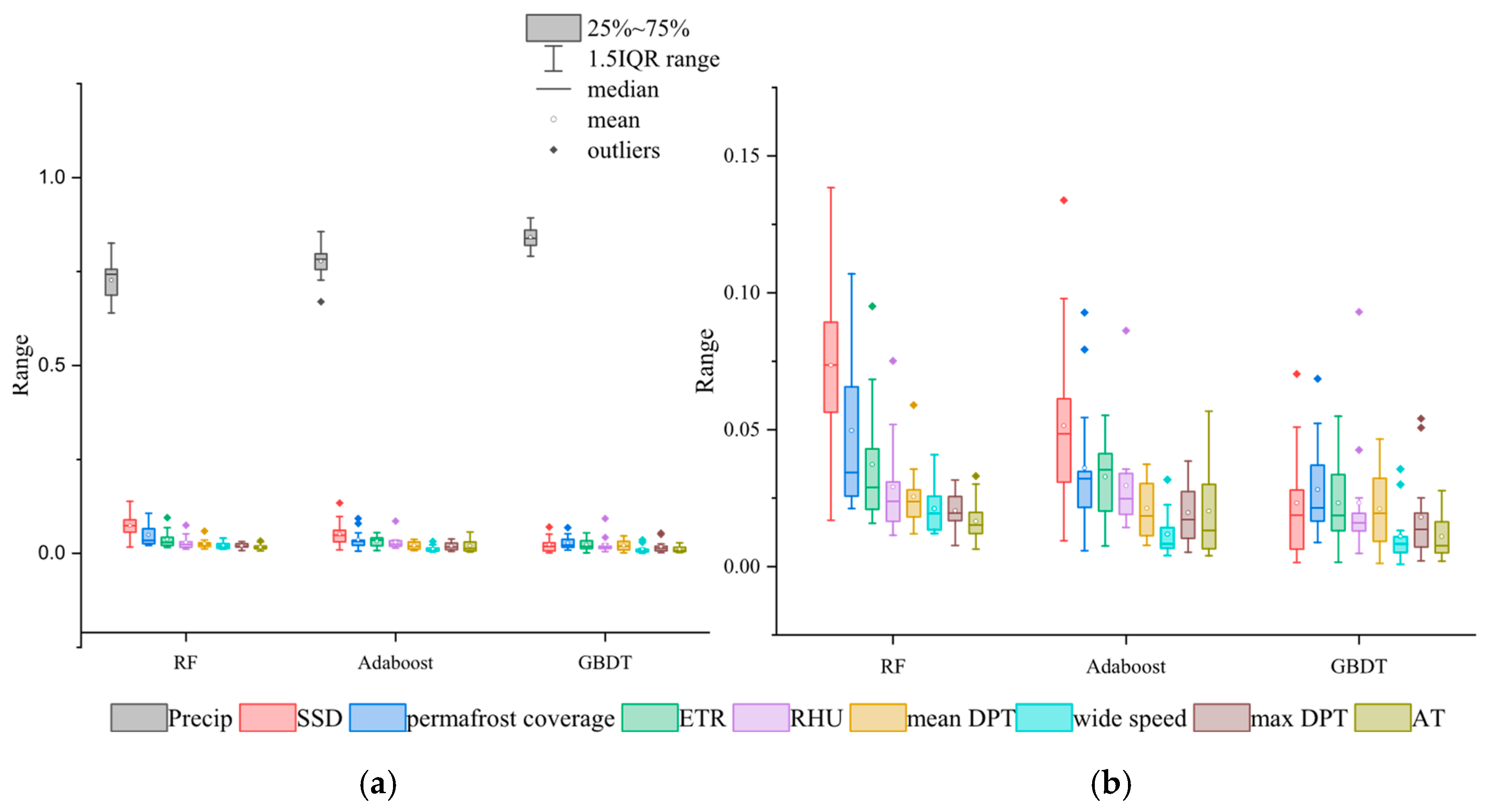Recognition and Prediction of Collaborative Response Characteristics of Runoff and Permafrost to Climate Changes in the Headwaters of the Yellow River
Abstract
1. Introduction
2. Materials and Methods
2.1. Evaluation Model for Importance of Features
2.1.1. RF Algorithm for Feature Selection
2.1.2. AdaBoost Algorithm for Feature Selection
2.1.3. GBDT Algorithm for Feature Selection
2.1.4. Comprehensive Evaluation Indices
2.2. Prediction Models
2.2.1. RF Regression Algorithm
2.2.2. SVM Algorithm
2.2.3. Validation of the Prediction Model
3. Results
3.1. Impact of Climate Changes on Permafrost Degradation
3.2. Impact of Climate Changes and Permafrost Degradation on Runoff
3.3. Validation of Impact Pattern of Climate Changes and Permafrost Degradation to Runoff
4. Discussion
5. Conclusions
- (1)
- All of the chosen climate factors were significant influencing factors. Air temperature was the primary climate factor that influenced the mean DPT in the study area. The importance ranking of climatic variables to mean values of DPT was as follows: air temperature > evapotranspiration > wind speed > RHU > sunshine duration > precipitation.
- (2)
- Precipitation had the most significant influence on runoff. Air temperature and maximum DPT had a relatively small but significant influence on runoff. The contribution ranking of climatic and permafrost variables to runoff was as follows: precipitation > sunshine duration > permafrost coverage > evapotranspiration > relative humidity (RHU) > mean DPT > wind speed > maximum DPT > air temperature.
- (3)
- High-accuracy prediction models of the mean DPT and runoff depth were successfully obtained using RF and SVM algorithms. The combined prediction model based on the RF algorithm was superior and had a better prediction effect than the one based on the SVM algorithm in predicting the mean DPT. However, in predicting runoff, the SVM algorithm outperformed the RF algorithm and had a significantly better prediction effect.
Author Contributions
Funding
Data Availability Statement
Acknowledgments
Conflicts of Interest
References
- Luo, S.Q.; Wang, J.Y.; Pomeroy, J.W.; Lyu, S.H. Freeze-Thaw Changes of Seasonally Frozen Ground on the Tibetan Plateau from 1960 to 2014. J. Clim. 2020, 33, 9427–9446. [Google Scholar] [CrossRef]
- Wang, G.; Wang, Y. Sensitivity Analysis About Runoff of Unper and Middle of the Yellow River to Climate Change. Water Resour. Water Eng. 2000, 11, 1–5. [Google Scholar]
- Walvoord, M.A.; Kurylyk, B.L. Hydrologic Impacts of Thawing Permafrost—A Review. Vadose Zone J. 2016, 15, 1–20. [Google Scholar] [CrossRef]
- Yuan, G.; Wu, Z.; Che, A.; Zhou, H. Damage Evolution Mechanism of Loess Slope under the Combination of Freeze-Thaw Cycles and Earthquake. Soil Dyn. Earthq. Eng. 2023, 166, 107778. [Google Scholar] [CrossRef]
- Shugar, D.H.; Jacquemart, M.; Shean, D.; Bhushan, S.; Upadhyay, K.; Sattar, A.; Schwanghart, W.; McBride, S.; de Vries, M.V.W.; Mergili, M.; et al. A Massive Rock and Ice Avalanche Caused the 2021 Disaster at Chamoli, Indian Himalaya. Science 2021, 373, 300–306. [Google Scholar] [CrossRef] [PubMed]
- Streletskiy, D.A.; Clemens, S.; Lanckman, J.-P.; Shiklomanov, N. The Costs of Arctic Infrastructure Damages Due to Permafrost Degradation. Environ. Res. Lett. 2023, 18, 015006. [Google Scholar] [CrossRef]
- Zhang, Y.; Liu, L.; Bai, W.; Shen, Z.; Yan, J.; Ding, M.; Li, S.; Zheng, D. Grassland Degradation in the Source Region of the Yellow River. Acta Geogr. Sin. 2006, 61, 3–14. [Google Scholar]
- Walvoord, M.A.; Voss, C.I.; Wellman, T.P. Influence of Permafrost Distribution on Groundwater Flow in the Context of Climate-Driven Permafrost Thaw: Example from Yukon Flats Basin, Alaska, United States. Water Resour. Res. 2012, 48, W07524. [Google Scholar] [CrossRef]
- Jin, H.J.; He, R.X.; Cheng, G.D.; Wu, Q.B.; Wang, S.L.; Chang, X.L. Changes in Frozen Ground in the Source Area of the Yellow River on the Qinghai-Tibet Plateau, China, and Their Eco-Environmental Impacts. Environ. Res. Lett. 2009, 4, 045206. [Google Scholar] [CrossRef]
- Zhang, S.; Wang, Y.; Zhao, Y.; Huang, Y.; Li, Y.; Shi, W.; Shang, X. Permafrost Degradation and Its Environmental Sequent in the Source Regions of the Yellow River. J. Glaciolgy Geocryol. 2004, 26, 10025829438. [Google Scholar]
- Cheng, G.; Jin, H. Groundwater in the permafrost regions on the Qinghai-Tibet Plateau and it changes. Hydrogeol. Eng. Geol. 2013, 40, 1–11. [Google Scholar]
- Yamazaki, Y.; Kubota, J.; Ohata, T.; Vuglinsky, V.; Mizuyama, T. Seasonal Changes in Runoff Characteristics on a Permafrost Watershed in the Southern Mountainous Region of Eastern Siberia. Hydrol. Process. 2006, 20, 453–467. [Google Scholar] [CrossRef]
- Zhang, T.; Stamnes, K. Impact of Climatic Factors on the Active Layer and Permafrost at Barrow, Alaska. Permafr. Periglac. Process. 1998, 9, 229–246. [Google Scholar] [CrossRef]
- Wu, J.; Sheng, Y.; Wu, Q.; Wen, Z. The Permafrost Degradation Pattern on Qinghai-Tibet Plateau. Sci. China (D Earth Sci.) 2009, 39, 1570–1578. [Google Scholar] [CrossRef]
- Zhao, L.; Hu, G.; Zou, D.; Wu, X.; Ma, L.; Sun, Z.; Yuan, L.; Zhou, H.; Liu, S. Permafrost Changes and Its Effects on Hydrological Processes on Qinghai-Tibet Plateau. Bull. Chin. Acad. Sci. 2019, 34, 1233–1246. [Google Scholar] [CrossRef]
- Liu, J.; Xie, J.; Hong, W.; Wang, H.; Xie, Y. Impacts of Winter Warming and Permafrost Degradation on Water Variability, Upper Lhasa River, Tibet. Quat. Int. 2011, 244, 178–184. [Google Scholar] [CrossRef]
- Liu, J.; Hayakawa, N.; Lu, M.; Dong, S.; Yuan, J. Hydrological and Geocryological Response of Winter Streamflow to Climate Warming in Northeast China. Cold Reg. Sci. Technol. 2003, 37, 15–24. [Google Scholar] [CrossRef]
- Li, D.; Tian, Y.; Liu, C. Distributed Hydrological Simulation of the Source Regions of the Yellow River under Environmental Changes. Acta Geogr. Sin. 2004, 59, 565–573. [Google Scholar]
- Wang, X.; Li, H.; Chen, R.; Liu, J.; Liu, G.; Han, C. Runoff Evolution Characteristics and Driving Factors of Yellow River Above Lanzhou Station from 1956 to 2020 Under Changing Environment. Adv. Earth Sci. 2022, 37, 726–741. [Google Scholar]
- Wang, G.; Mao, T.; Chang, J.; Song, C.; Huang, K. Processes of Runoff Generation Operating during the Spring and Autumn Seasons in a Permafrost Catchment on Semi-Arid Plateaus. J. Hydrol. 2017, 550, 307–317. [Google Scholar] [CrossRef]
- Song, C.; Wang, G.; Mao, T.; Dai, J.; Yang, D. Linkage between Permafrost Distribution and River Runoff Changes across the Arctic and the Tibetan Plateau. Sci. China-Earth Sci. 2020, 63, 292–302. [Google Scholar] [CrossRef]
- Sun, A.; Yu, Z.; Zhou, J.; Acharya, K.; Ju, Q.; Xing, R.; Huang, D.; Wen, L. Quantified Hydrological Responses to Permafrost Degradation in the Headwaters of the Yellow River (HWYR) in High Asia. Sci. Total Environ. 2020, 712, 135632. [Google Scholar] [CrossRef]
- Sun, A.; Zhou, J.; Yu, Z.; Jin, H.; Sheng, Y.; Yang, C. Three-Dimensional Distribution of Permafrost and Responses to Increasing Air Temperatures in the Head Waters of the Yellow River in High Asia. Sci. Total Environ. 2019, 666, 321–336. [Google Scholar] [CrossRef] [PubMed]
- Sun, A.; Zhou, J.; Yu, Z.; Su, X.; Song, S.; Wu, Q.; Schulla, J. Quantified Spatial-Temporal Variation of the Fine-Scale Frozen Soils during 1980-2014 in the Headwaters of the Yellow River (HWYR) in High Mountain Asia. Catena 2023, 222, 106836. [Google Scholar] [CrossRef]
- Li, Q.; Zhao, D.; Yin, J.; Zhou, X.; Li, Y.; Chi, P.; Han, Y.; Ansari, U.; Cheng, Y. Sediment Instability Caused by Gas Production from Hydrate-Bearing Sediment in Northern South China Sea by Horizontal Wellbore: Evolution and Mechanism. Nat. Resour. Res. 2023, 1–26. [Google Scholar] [CrossRef]
- Li, Q.; Zhang, C.; Yang, Y.; Ansari, U.; Han, Y.; Li, X.; Cheng, Y. Preliminary Experimental Investigation on Long-Term Fracture Conductivity for Evaluating the Feasibility and Efficiency of Fracturing Operation in Offshore Hydrate-Bearing Sediments. Ocean Eng. 2023, 281, 114949. [Google Scholar] [CrossRef]
- Wang, F.; Liu, X.; Jiang, B.; Zhuo, H.; Chen, W.; Chen, Y.; Li, X. Low-Loading Pt Nanoparticles Combined with the Atomically Dispersed FeN4 Sites Supported by FeSA-N-C for Improved Activity and Stability towards Oxygen Reduction Reaction/Hydrogen Evolution Reaction in Acid and Alkaline Media. J. Colloid Interface Sci. 2023, 635, 514–523. [Google Scholar] [CrossRef]
- Stańczyk, U. Ranking of Characteristic Features in Combined Wrapper Approaches to Selection. Neural Comput. Appl. 2015, 26, 329–344. [Google Scholar] [CrossRef]
- Liu, X.-Y.; Liang, Y.; Wang, S.; Yang, Z.-Y.; Ye, H.-S. A Hybrid Genetic Algorithm With Wrapper-Embedded Approaches for Feature Selection. IEEE Access 2018, 6, 22863–22874. [Google Scholar] [CrossRef]
- Peng, Z.; Liu, Q.; Zhang, Y. Short Term Load Forecasting Based on Multi-Model Comprehensive FeatureSelection and LSTM-Attention. Distrib. Energy 2022, 7, 11–20. [Google Scholar]
- Wang, B.; Zhuang, J.; Xiong, J.; Luo, X. HDFC-RF Algorithm Based on High-Dimensional Feature Clusting Optimization. J. Jinggangshan Univ. (Nat. Sci.) 2022, 43, 52–56. [Google Scholar]
- Jia, K.; Xuan, Z.; Lin, Y.; Wei, H.; Li, G. An Islanding Detection Method for Grid-Connected Photovoltaic Power System Based on Adaboost Algorithm. Trans. China Electrotech. Soc. 2018, 33, 1106–1113. [Google Scholar]
- Meng, R.; Shen, W.; Luan, K.; Ji, Q.; Rao, Y. Water Depth Retrieval Based on Gradient Boosting Decision Tree Algorithm. Trans. Oceanol. Limnol. 2023, 45, 45–50. [Google Scholar]
- Yan, B.; Wang, X.; Jiang, Z. Study on the Gaze Estimation Algorithm Based on Support Vector Regression Model. Chin. J. Sci. Instrum. 2014, 35, 2299–2305. [Google Scholar]
- Li, S.; Liu, L.; Rong, J.; Zhou, W.; Liu, L. Atmospheric Weighted Mean Temperature Based on Support Vector Regression. J. Guilin Univ. Technol. 2019, 39, 656–660. [Google Scholar]
- Peng, X.; Mu, C. Changes of Soil Thermal and Hydraulic Regimes in the Heihe River Basin. Environ. Monit. Assess. 2017, 189, 483. [Google Scholar] [CrossRef]
- Henry, H.A.L. Climate Change and Soil Freezing Dynamics: Historical Trends and Projected Changes. Clim. Chang. 2008, 87, 421–434. [Google Scholar] [CrossRef]
- Wang, R.; Dong, Z.B.; Zhou, Z.C. Effect of Decreasing Soil Frozen Depth on Vegetation Growth in the Source Region of the Yellow River for 1982–2015. Theor. Appl. Climatol. 2020, 140, 1185–1197. [Google Scholar] [CrossRef]
- Peng, X.Q.; Zhang, T.J.; Frauenfeld, O.W.; Wang, K.; Cao, B.; Zhong, X.Y.; Su, H.; Mu, C.C. Response of Seasonal Soil Freeze Depth to Climate Change across China. Cryosphere 2017, 11, 1059–1073. [Google Scholar] [CrossRef]
- Kane, D.L.; Hinzman, L.D.; Zarling, J.P. Thermal Response of the Active Layer to Climatic Warming in a Permafrost Environment. Cold Reg. Sci. Technol. 1991, 19, 111–122. [Google Scholar] [CrossRef]
- Gao, B.; Li, J.; Wang, X.S. Impact of Frozen Soil Changes on Vegetation Phenology in the Source Region of the Yellow River from 2003 to 2015. Theor. Appl. Climatol. 2020, 141, 1219–1234. [Google Scholar] [CrossRef]
- Ding, M.; Zhang, Y.; Liu, L.; Zhang, W.; Wang, Z.; Bai, W. The Relationship between NDVI and Precipitation on the Tibetan Plateau. J. Geogr. Sci. 2007, 17, 259–268. [Google Scholar] [CrossRef]
- Kalyuzhnyi, I.L.; Lavrov, S.A. Mechanism of the Influence of Soil Freezing Depth on Winter Runoff. Water Resour. 2017, 44, 604–613. [Google Scholar] [CrossRef]
- Niu, L.; Ye, B.; Li, J.; Sheng, Y. Effect of Permafrost Degradation on Hydrological Processes in Typical Basins with Various Permafrost Coverage in Western China. Sci. China Earth Sci. 2011, 41, 85–92. [Google Scholar] [CrossRef]
- Kalyuzhnyi, I.L.; Lavrov, S.A. Basic Physical Processes and Regularities of Winter and Spring River Runoff Formation under Climate Warming Conditions. Russ. Meteorol. Hydrol. 2012, 37, 47–56. [Google Scholar] [CrossRef]






| Features | RF | Adaboost | GBDT | Comprehensive Contribution Coefficient |
|---|---|---|---|---|
| Air temperature | 0.482 | 0.515 | 0.575 | 1.573 |
| Evapotranspiration | 0.161 | 0.196 | 0.209 | 0.566 |
| Wind speed | 0.154 | 0.111 | 0.082 | 0.348 |
| RHU | 0.099 | 0.080 | 0.057 | 0.236 |
| Sunshine duration | 0.056 | 0.055 | 0.040 | 0.151 |
| Precipitation | 0.047 | 0.042 | 0.037 | 0.126 |
| Features | RF | Adaboost | GBDT | Comprehensive Contribution Coefficient |
|---|---|---|---|---|
| Precipitation | 0.7268 | 0.7772 | 0.8412 | 2.3452 |
| Sunshine duration | 0.0735 | 0.0515 | 0.0232 | 0.1482 |
| Permafrost coverage | 0.0497 | 0.0360 | 0.0281 | 0.1138 |
| Evapotranspiration | 0.0373 | 0.0328 | 0.0232 | 0.0932 |
| RHU | 0.0291 | 0.0296 | 0.0232 | 0.0819 |
| Mean DPT | 0.0256 | 0.0213 | 0.0211 | 0.0679 |
| wind speed | 0.0204 | 0.0197 | 0.0180 | 0.0581 |
| Maximum DPT | 0.0165 | 0.0202 | 0.0110 | 0.0477 |
| air temperature | 0.0211 | 0.0118 | 0.0110 | 0.0439 |
| Models | RF | SVM | ||||
|---|---|---|---|---|---|---|
| Feature Set | Optimal Features | Feature 1 | Feature 2 | Optimal Features | Feature 1 | Feature 2 |
| RMSE | 0.11 | 0.19 | 0.19 | 0.33 | 0.41 | 0.48 |
| MAE | 0.08 | 0.15 | 0.16 | 0.28 | 0.32 | 0.31 |
| R2 | 0.89 | 0.81 | 0.84 | 0.86 | 0.79 | 0.75 |
| Models | RF | SVM | ||||
|---|---|---|---|---|---|---|
| Feature Sets | Optimal Features | AB Features | Original Features | Optimal Features | AB Features | Original Features |
| RMSE | 24.66 | 24.80 | 26.57 | 7.69 | 7.93 | 8.04 |
| MAE | 18.55 | 18.71 | 20.55 | 5.94 | 6.33 | 6.54 |
| R2 | 0.81 | 0.80 | 0.78 | 0.95 | 0.95 | 0.94 |
Disclaimer/Publisher’s Note: The statements, opinions and data contained in all publications are solely those of the individual author(s) and contributor(s) and not of MDPI and/or the editor(s). MDPI and/or the editor(s) disclaim responsibility for any injury to people or property resulting from any ideas, methods, instructions or products referred to in the content. |
© 2023 by the authors. Licensee MDPI, Basel, Switzerland. This article is an open access article distributed under the terms and conditions of the Creative Commons Attribution (CC BY) license (https://creativecommons.org/licenses/by/4.0/).
Share and Cite
Han, X.; Sun, A.; Meng, X.; Liang, Y.; Shen, Y.; Bai, Y.; Wang, B.; Meng, H.; He, R. Recognition and Prediction of Collaborative Response Characteristics of Runoff and Permafrost to Climate Changes in the Headwaters of the Yellow River. Water 2023, 15, 2347. https://doi.org/10.3390/w15132347
Han X, Sun A, Meng X, Liang Y, Shen Y, Bai Y, Wang B, Meng H, He R. Recognition and Prediction of Collaborative Response Characteristics of Runoff and Permafrost to Climate Changes in the Headwaters of the Yellow River. Water. 2023; 15(13):2347. https://doi.org/10.3390/w15132347
Chicago/Turabian StyleHan, Xinze, Aili Sun, Xue Meng, Yongshan Liang, Yanqing Shen, Yu Bai, Boyuan Wang, Haojie Meng, and Ruifei He. 2023. "Recognition and Prediction of Collaborative Response Characteristics of Runoff and Permafrost to Climate Changes in the Headwaters of the Yellow River" Water 15, no. 13: 2347. https://doi.org/10.3390/w15132347
APA StyleHan, X., Sun, A., Meng, X., Liang, Y., Shen, Y., Bai, Y., Wang, B., Meng, H., & He, R. (2023). Recognition and Prediction of Collaborative Response Characteristics of Runoff and Permafrost to Climate Changes in the Headwaters of the Yellow River. Water, 15(13), 2347. https://doi.org/10.3390/w15132347










